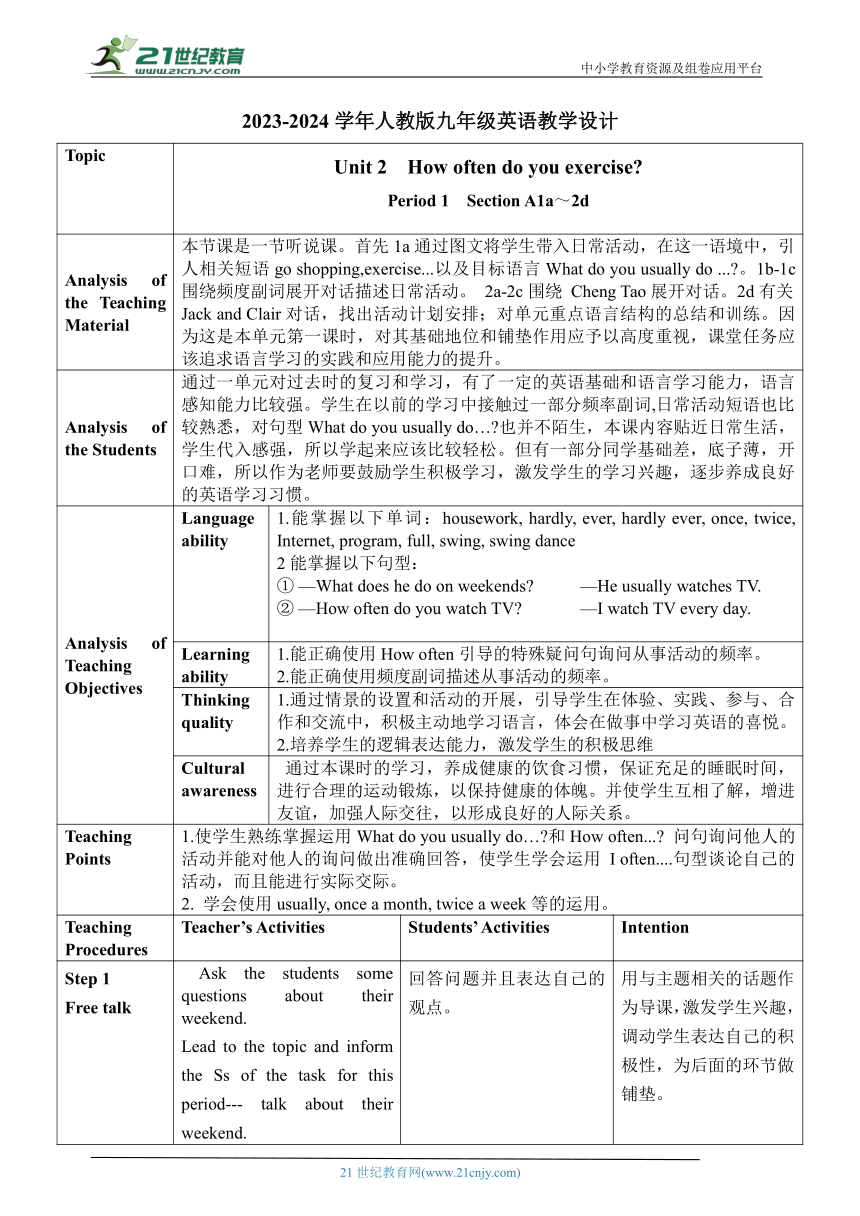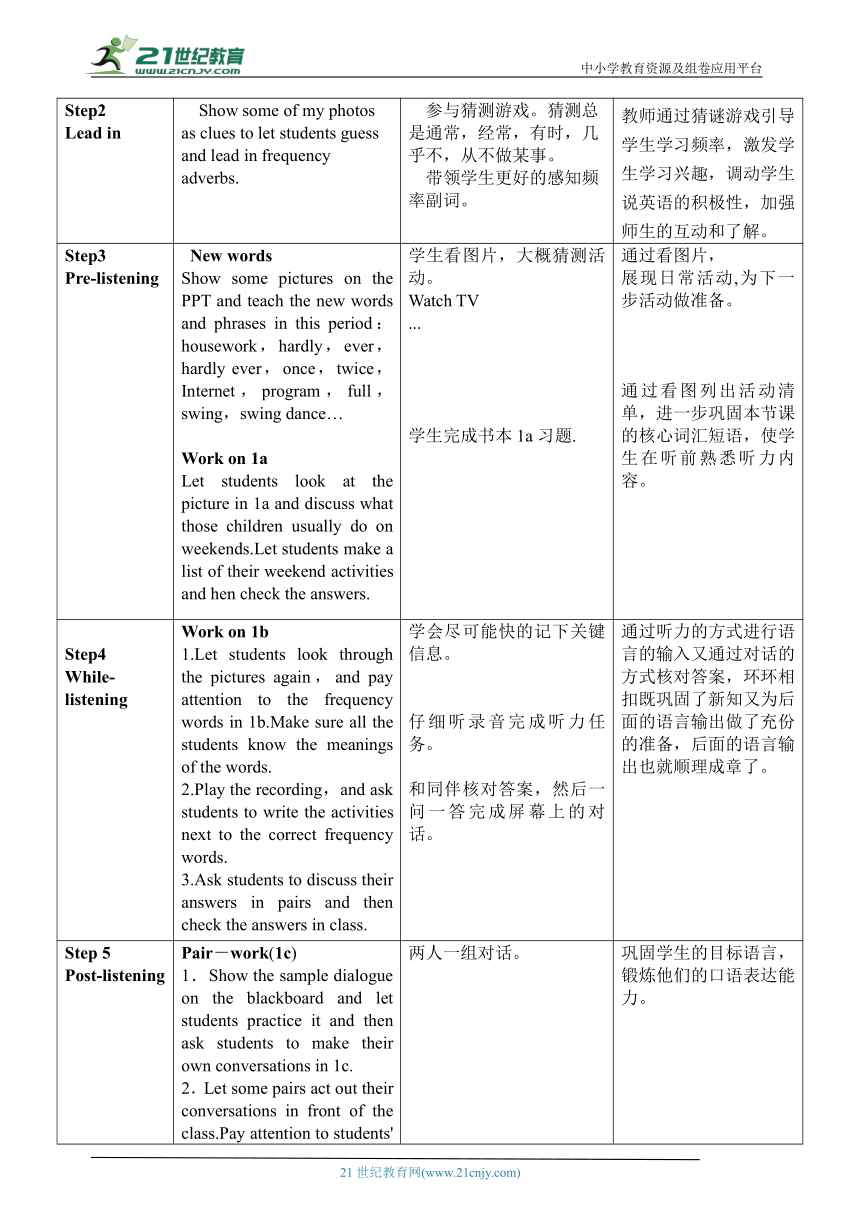【核心素养目标】Unit 2 How often do you exercise Section A1a~2d 表格式教学设计 人教版八年级英语上
文档属性
| 名称 | 【核心素养目标】Unit 2 How often do you exercise Section A1a~2d 表格式教学设计 人教版八年级英语上 |  | |
| 格式 | doc | ||
| 文件大小 | 188.1KB | ||
| 资源类型 | 试卷 | ||
| 版本资源 | 人教新目标(Go for it)版 | ||
| 科目 | 英语 | ||
| 更新时间 | 2023-09-15 07:01:19 | ||
图片预览


文档简介
中小学教育资源及组卷应用平台
2023-2024学年人教版九年级英语教学设计
Topic Unit 2 How often do you exercise Period 1 Section A1a~2d
Analysis of the Teaching Material 本节课是一节听说课。首先1a通过图文将学生带入日常活动,在这一语境中,引人相关短语go shopping,exercise...以及目标语言What do you usually do ... 。1b-1c围绕频度副词展开对话描述日常活动。 2a-2c围绕 Cheng Tao展开对话。2d有关Jack and Clair对话,找出活动计划安排;对单元重点语言结构的总结和训练。因为这是本单元第一课时,对其基础地位和铺垫作用应予以高度重视,课堂任务应该追求语言学习的实践和应用能力的提升。
Analysis of the Students 通过一单元对过去时的复习和学习,有了一定的英语基础和语言学习能力,语言感知能力比较强。学生在以前的学习中接触过一部分频率副词,日常活动短语也比较熟悉,对句型What do you usually do… 也并不陌生,本课内容贴近日常生活,学生代入感强,所以学起来应该比较轻松。但有一部分同学基础差,底子薄,开口难,所以作为老师要鼓励学生积极学习,激发学生的学习兴趣,逐步养成良好的英语学习习惯。
Analysis of Teaching Objectives Language ability 1.能掌握以下单词:housework, hardly, ever, hardly ever, once, twice, Internet, program, full, swing, swing dance 2能掌握以下句型:① —What does he do on weekends —He usually watches TV. ② —How often do you watch TV —I watch TV every day.
Learningability 1.能正确使用How often引导的特殊疑问句询问从事活动的频率。2.能正确使用频度副词描述从事活动的频率。
Thinking quality 1.通过情景的设置和活动的开展,引导学生在体验、实践、参与、合作和交流中,积极主动地学习语言,体会在做事中学习英语的喜悦。2.培养学生的逻辑表达能力,激发学生的积极思维
Cultural awareness 通过本课时的学习,养成健康的饮食习惯,保证充足的睡眠时间,进行合理的运动锻炼,以保持健康的体魄。并使学生互相了解,增进友谊,加强人际交往,以形成良好的人际关系。
Teaching Points 1.使学生熟练掌握运用What do you usually do… 和How often... 问句询问他人的活动并能对他人的询问做出准确回答,使学生学会运用 I often....句型谈论自己的活动,而且能进行实际交际。2. 学会使用usually, once a month, twice a week等的运用。
Teaching Procedures Teacher’s Activities Students’ Activities Intention
Step 1Free talk Ask the students some questions about their weekend.Lead to the topic and inform the Ss of the task for this period--- talk about their weekend. 回答问题并且表达自己的观点。 用与主题相关的话题作为导课,激发学生兴趣,调动学生表达自己的积极性,为后面的环节做铺垫。
Step2 Lead in Show some of my photos as clues to let students guess and lead in frequency adverbs. 参与猜测游戏。猜测总是通常,经常,有时,几乎不,从不做某事。带领学生更好的感知频率副词。 教师通过猜谜游戏引导学生学习频率,激发学生学习兴趣,调动学生说英语的积极性,加强师生的互动和了解。
Step3Pre-listening New wordsShow some pictures on the PPT and teach the new words and phrases in this period:housework,hardly,ever,hardly ever,once,twice,Internet,program,full,swing,swing dance…Work on 1aLet students look at the picture in 1a and discuss what those children usually do on weekends.Let students make a list of their weekend activities and hen check the answers. 学生看图片,大概猜测活动。Watch TV...学生完成书本1a习题. 通过看图片,展现日常活动,为下一步活动做准备。通过看图列出活动清单,进一步巩固本节课的核心词汇短语,使学生在听前熟悉听力内容。
Step4While-listening Work on 1b1.Let students look through the pictures again,and pay attention to the frequency words in 1b.Make sure all the students know the meanings of the words.2.Play the recording,and ask students to write the activities next to the correct frequency words.3.Ask students to discuss their answers in pairs and then check the answers in class. 学会尽可能快的记下关键信息。仔细听录音完成听力任务。和同伴核对答案,然后一问一答完成屏幕上的对话。 通过听力的方式进行语言的输入又通过对话的方式核对答案,环环相扣既巩固了新知又为后面的语言输出做了充份的准备,后面的语言输出也就顺理成章了。
Step 5Post-listening Pair-work(1c)1.Show the sample dialogue on the blackboard and let students practice it and then ask students to make their own conversations in 1c.2.Let some pairs act out their conversations in front of the class.Pay attention to students' pronunciation and intonation. 两人一组对话。 巩固学生的目标语言,锻炼他们的口语表达能力。
Step6While-listening Work on 2a1.Show students the chart in 2a,and ask them to listen to the recording carefully.Work on 2b1.Show students the chart in 2a again,and ask them to pay attention to the frequency words.2.Play the recording again and let students match the activities in 2a with how often Cheng Tao does them.Then check the answers in class. 完成2a,2b听力练习。 让学生在听的过程中掌握提取关键词的方法。练习并模仿目标语言,掌握正确的语音和语调。熟悉听力材料中的关键词,并复习新学词汇。
Step 7Post-listening Pair-work(2c)1.Ask students to summarize the key expressions in the listening recording in groups.2.Let students fill in the chart about how often they do these activities and then make their own conversations according to their answers in the chart.Role-play(2d)1.Show students the picture in 2d.Then lead students to learn the dialogue as follows:T:What are they doing Ss:They are dancing.2.Have students read the dialogue and answer the questions 学生自由结合对话,根据对话内容进行角色扮演。大胆进行口语输出,学生根据问题进行回答。 让学生带着问题阅读对话能够帮助学生更好地理解对话内容。模仿朗读,并以表演的形式,让学生将所学内容进行输出。学练结合的形式进行反复训练,加强理解记忆,达到灵活运用所学知识的目的。以图片形式引入话题,让学生带着问题自读课文,可以提高学生的阅读能力。
Step 8 Speaking Game time*Group work *Pair workSharing “how often…..Do you….”. Guide the students to play the game and show it on the big screen. 写下造的有趣的句子。两人一组大声读出来。 这部分的设计目的通过游戏的方式激起学生学习的兴趣,愿意并主动用英语表达所学的知识。本环节是首先是全班的集体活动对每个同学都有所分工并能参与到活动中,然后再通过对话展示使得所学知识再次呈现,同时检测整节课的教学目标是否达成。
Step 9Summary Summarize the key content in this lesson. 跟随老师一起进行内容总结。 总结本课所学内容,利用将思维导图给学生进行有序的梳理。
Homework 1.Make conversations about your weekend activities and write them down.2.Write a passage about “My weekend” in not fewer than 60 words; try to use words and sentences learned in this class.
Blackboard Design Unit 2 How often do you exercise Period 1 Section A1a~2dFrequency words How often never once a dayhardly ever twice a weeksometimes three times a monthoften four times a year usuallyalways
Teaching Reflection: 教学反思:任务型教学法有助于学生根据任务展开讨论和思考; 以学生为主体,构建有效的对话情境,贴近学生实际生活;板书简洁清晰,重点突出,对学生的复述起到了很好的辅助作用。
21世纪教育网 www.21cnjy.com 精品试卷·第 2 页 (共 2 页)
HYPERLINK "http://www.21cnjy.com/" 21世纪教育网(www.21cnjy.com)
2023-2024学年人教版九年级英语教学设计
Topic Unit 2 How often do you exercise Period 1 Section A1a~2d
Analysis of the Teaching Material 本节课是一节听说课。首先1a通过图文将学生带入日常活动,在这一语境中,引人相关短语go shopping,exercise...以及目标语言What do you usually do ... 。1b-1c围绕频度副词展开对话描述日常活动。 2a-2c围绕 Cheng Tao展开对话。2d有关Jack and Clair对话,找出活动计划安排;对单元重点语言结构的总结和训练。因为这是本单元第一课时,对其基础地位和铺垫作用应予以高度重视,课堂任务应该追求语言学习的实践和应用能力的提升。
Analysis of the Students 通过一单元对过去时的复习和学习,有了一定的英语基础和语言学习能力,语言感知能力比较强。学生在以前的学习中接触过一部分频率副词,日常活动短语也比较熟悉,对句型What do you usually do… 也并不陌生,本课内容贴近日常生活,学生代入感强,所以学起来应该比较轻松。但有一部分同学基础差,底子薄,开口难,所以作为老师要鼓励学生积极学习,激发学生的学习兴趣,逐步养成良好的英语学习习惯。
Analysis of Teaching Objectives Language ability 1.能掌握以下单词:housework, hardly, ever, hardly ever, once, twice, Internet, program, full, swing, swing dance 2能掌握以下句型:① —What does he do on weekends —He usually watches TV. ② —How often do you watch TV —I watch TV every day.
Learningability 1.能正确使用How often引导的特殊疑问句询问从事活动的频率。2.能正确使用频度副词描述从事活动的频率。
Thinking quality 1.通过情景的设置和活动的开展,引导学生在体验、实践、参与、合作和交流中,积极主动地学习语言,体会在做事中学习英语的喜悦。2.培养学生的逻辑表达能力,激发学生的积极思维
Cultural awareness 通过本课时的学习,养成健康的饮食习惯,保证充足的睡眠时间,进行合理的运动锻炼,以保持健康的体魄。并使学生互相了解,增进友谊,加强人际交往,以形成良好的人际关系。
Teaching Points 1.使学生熟练掌握运用What do you usually do… 和How often... 问句询问他人的活动并能对他人的询问做出准确回答,使学生学会运用 I often....句型谈论自己的活动,而且能进行实际交际。2. 学会使用usually, once a month, twice a week等的运用。
Teaching Procedures Teacher’s Activities Students’ Activities Intention
Step 1Free talk Ask the students some questions about their weekend.Lead to the topic and inform the Ss of the task for this period--- talk about their weekend. 回答问题并且表达自己的观点。 用与主题相关的话题作为导课,激发学生兴趣,调动学生表达自己的积极性,为后面的环节做铺垫。
Step2 Lead in Show some of my photos as clues to let students guess and lead in frequency adverbs. 参与猜测游戏。猜测总是通常,经常,有时,几乎不,从不做某事。带领学生更好的感知频率副词。 教师通过猜谜游戏引导学生学习频率,激发学生学习兴趣,调动学生说英语的积极性,加强师生的互动和了解。
Step3Pre-listening New wordsShow some pictures on the PPT and teach the new words and phrases in this period:housework,hardly,ever,hardly ever,once,twice,Internet,program,full,swing,swing dance…Work on 1aLet students look at the picture in 1a and discuss what those children usually do on weekends.Let students make a list of their weekend activities and hen check the answers. 学生看图片,大概猜测活动。Watch TV...学生完成书本1a习题. 通过看图片,展现日常活动,为下一步活动做准备。通过看图列出活动清单,进一步巩固本节课的核心词汇短语,使学生在听前熟悉听力内容。
Step4While-listening Work on 1b1.Let students look through the pictures again,and pay attention to the frequency words in 1b.Make sure all the students know the meanings of the words.2.Play the recording,and ask students to write the activities next to the correct frequency words.3.Ask students to discuss their answers in pairs and then check the answers in class. 学会尽可能快的记下关键信息。仔细听录音完成听力任务。和同伴核对答案,然后一问一答完成屏幕上的对话。 通过听力的方式进行语言的输入又通过对话的方式核对答案,环环相扣既巩固了新知又为后面的语言输出做了充份的准备,后面的语言输出也就顺理成章了。
Step 5Post-listening Pair-work(1c)1.Show the sample dialogue on the blackboard and let students practice it and then ask students to make their own conversations in 1c.2.Let some pairs act out their conversations in front of the class.Pay attention to students' pronunciation and intonation. 两人一组对话。 巩固学生的目标语言,锻炼他们的口语表达能力。
Step6While-listening Work on 2a1.Show students the chart in 2a,and ask them to listen to the recording carefully.Work on 2b1.Show students the chart in 2a again,and ask them to pay attention to the frequency words.2.Play the recording again and let students match the activities in 2a with how often Cheng Tao does them.Then check the answers in class. 完成2a,2b听力练习。 让学生在听的过程中掌握提取关键词的方法。练习并模仿目标语言,掌握正确的语音和语调。熟悉听力材料中的关键词,并复习新学词汇。
Step 7Post-listening Pair-work(2c)1.Ask students to summarize the key expressions in the listening recording in groups.2.Let students fill in the chart about how often they do these activities and then make their own conversations according to their answers in the chart.Role-play(2d)1.Show students the picture in 2d.Then lead students to learn the dialogue as follows:T:What are they doing Ss:They are dancing.2.Have students read the dialogue and answer the questions 学生自由结合对话,根据对话内容进行角色扮演。大胆进行口语输出,学生根据问题进行回答。 让学生带着问题阅读对话能够帮助学生更好地理解对话内容。模仿朗读,并以表演的形式,让学生将所学内容进行输出。学练结合的形式进行反复训练,加强理解记忆,达到灵活运用所学知识的目的。以图片形式引入话题,让学生带着问题自读课文,可以提高学生的阅读能力。
Step 8 Speaking Game time*Group work *Pair workSharing “how often…..Do you….”. Guide the students to play the game and show it on the big screen. 写下造的有趣的句子。两人一组大声读出来。 这部分的设计目的通过游戏的方式激起学生学习的兴趣,愿意并主动用英语表达所学的知识。本环节是首先是全班的集体活动对每个同学都有所分工并能参与到活动中,然后再通过对话展示使得所学知识再次呈现,同时检测整节课的教学目标是否达成。
Step 9Summary Summarize the key content in this lesson. 跟随老师一起进行内容总结。 总结本课所学内容,利用将思维导图给学生进行有序的梳理。
Homework 1.Make conversations about your weekend activities and write them down.2.Write a passage about “My weekend” in not fewer than 60 words; try to use words and sentences learned in this class.
Blackboard Design Unit 2 How often do you exercise Period 1 Section A1a~2dFrequency words How often never once a dayhardly ever twice a weeksometimes three times a monthoften four times a year usuallyalways
Teaching Reflection: 教学反思:任务型教学法有助于学生根据任务展开讨论和思考; 以学生为主体,构建有效的对话情境,贴近学生实际生活;板书简洁清晰,重点突出,对学生的复述起到了很好的辅助作用。
21世纪教育网 www.21cnjy.com 精品试卷·第 2 页 (共 2 页)
HYPERLINK "http://www.21cnjy.com/" 21世纪教育网(www.21cnjy.com)
同课章节目录
- Unit 1 Where did you go on vacation?
- Section A
- Section B
- Unit 2 How often do you exercise?
- Section A
- Section B
- Unit 3 I'm more outgoing than my sister.
- Section A
- Section B
- Unit 4 What's the best movie theater?
- Section A
- Section B
- Unit 5 Do you want to watch a game show?
- Section A
- Section B
- Unit 6 I'm going to study computer science.
- Section A
- Section B
- Unit 7 Will people have robots?
- Section A
- Section B
- Unit 8 How do you make a banana milk shake?
- Section A
- Section B
- Unit 9 Can you come to my party?
- Section A
- Section B
- Unit 10 If you go to the party, you'll have a grea
- Section A
- Section B
